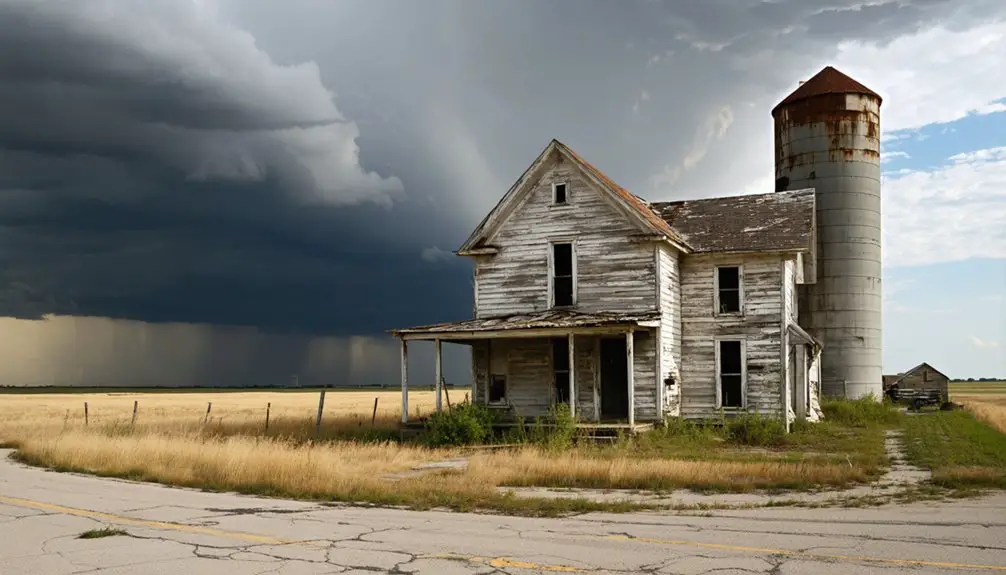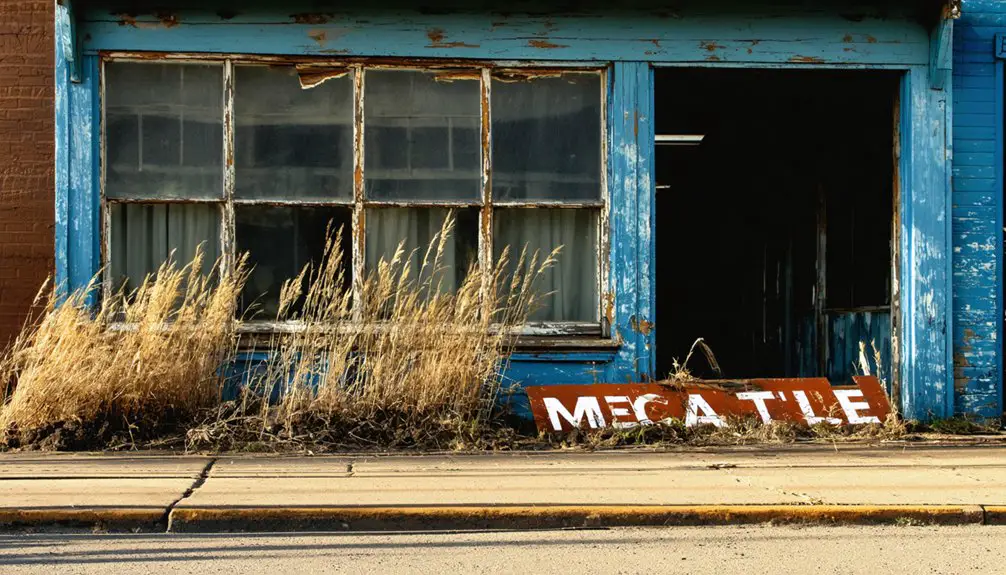You’ll find Louisville, Kansas, once a bustling frontier settlement established in 1857, now exists as a ghost town in Pottawatomie County. The town thrived initially through Louis Vieux’s essential ferry service along the Oregon Trail and later with the Great Iron Bridge of 1872. However, losing the county seat battle to Westmoreland in 1882, coupled with being bypassed by the Union Pacific Railroad, sealed Louisville’s fate. The town’s rich history of Native American heritage and pioneer ambitions holds fascinating untold stories.
Key Takeaways
- Louisville declined from a bustling stagecoach stop to a ghost town after being bypassed by the Union Pacific Railroad in 1882.
- The loss of county seat status to Westmoreland in 1882 triggered significant population decline and diminished regional influence.
- A devastating earthquake in 1875 damaged local infrastructure and contributed to the town’s instability and eventual abandonment.
- Major railroad carriers like Missouri Pacific and Frisco excluded Louisville from their networks, isolating it from economic opportunities.
- The town’s ferry-based transportation system became obsolete after bridge construction in 1871-1872, reducing its strategic importance.
Early Settlement and Native American Roots
Before becoming a frontier settlement, the Louisville area served as traditional Potawatomi hunting grounds, centered around the nearby Pottawatomie Indian Reservation.
The ancestral Potawatomi people roamed these lands as hunting grounds before settlers established what would become Louisville.
You’ll find strong evidence of Potawatomi heritage in figures like Louis Vieux Sr., a Potawatomi-French Métis who wielded significant influence through his position on the tribal council and role as a government negotiator.
In 1857, Robert Wilson established the settlement, initially naming it Rock Post. He and his sons built a frontier hotel at a strategic military road crossing on Rock Creek.
You’ll discover that early settlers like Henry Rammelt, Andrew Knoll, and Charles Jenkins soon followed, drawn by the location’s proximity to both the Fort Leavenworth-Fort Riley military road and Oregon Trail routes.
Like many African Americans seeking new opportunities during the Great Migration, these pioneers sought to establish their own autonomous community.
Father Gaillaud’s arrival in 1848 marked significant cultural bridging between settlers and the Potawatomi people. Like the original Louisville in Kentucky, this settlement was established as one of the earliest west of Appalachians.
The Naming Legacy of Two Louis
A fascinating convergence of histories emerged when Louisville, Kansas received its official name on July 19, 1867, honoring two influential men who shared the same first name. The town’s Louis legacy celebrates both Louis Wilson, son of founder Robert Wilson, and Louis Vieux, a prominent Potawatomi leader and businessman.
You’ll find this cultural blending particularly significant, as Vieux’s mixed Potawatomi and French-Canadian heritage bridged Native American and settler communities. He operated a vital ferry crossing on the Vermillion River and held considerable influence in both worlds. Like the Kanza Indians who originally inhabited the region’s lands, Vieux represented the rich Native American heritage of Kansas Territory. Similar to the town of Diamond Springs, Louisville served as an important stop for weary travelers along the Santa Fe Trail.
Meanwhile, the Wilson family’s contribution to founding the settlement made Louis Wilson’s namesake equally meaningful. This dual recognition in the town’s name stands as a reflection of the area’s unique intersection of settler and indigenous heritage.
River Crossings and Bridge Construction
The strategic importance of river crossings shaped Louisville’s early development, with Louis Vieux’s ferry service over the Vermillion River serving as an essential link for Oregon Trail travelers and Potawatomi Reservation commerce in the mid-1800s.
You’ll find that river commerce thrived during this period, as the crossing point became vital for both settlers and Native American trade. Like many frontier towns that started around crossings, it faced a similar fate to mining communities that eventually declined.
In 1871, bridge engineering transformed Louisville’s landscape when surrounding townships jointly funded the construction of the “Great Iron Bridge.”
The Louisville Bridge and Ferry company, chartered in 1866, facilitated crucial transportation needs before the bridge was built.
Completed in 1872, this modern structure replaced the ferry system that had operated for over seven years.
While the bridge provided more reliable year-round crossing and initially boosted local commerce, it couldn’t prevent Louisville’s eventual decline when the Union Pacific Railroad bypassed the town in favor of Wamego in 1882.
Quest for County Seat Status
You’ll find Louisville’s most ambitious political aspiration in its quest to become the permanent county seat of Pottawatomie County, which began shortly after its 1857 founding.
While the town briefly held the designation in 1861, it faced fierce competition from St. George and ultimately lost to Westmoreland in 1882.
The defeat marked a turning point in Louisville’s history, as the loss of county seat status triggered both a population decline and diminished regional influence that would contribute to the town’s eventual demise. Like many of the 6,000 ghost towns across Kansas, Louisville’s dreams of prosperity faded when it failed to secure its position as a county seat.
Similar county seat battles played out in Nemaha County, where Seneca won decisively against Richmond and other contending towns.
Political Battle Begins
Following its establishment in 1857, Louisville emerged as a fierce contender in Pottawatomie County’s heated battle for county seat status.
You’ll find that intense political maneuvering characterized this period, as Louisville’s strategic position near the Kansas River and Wamego made it an attractive choice for local governance. Similar to how Bell Plane Town Company strategically purchased land to establish their settlement, Louisville’s founders carefully selected their location. The town’s role as a stagecoach stop and its connection to the Smoky Hill Trail further strengthened its bid.
Despite briefly securing the county seat in 1861, Louisville’s victory was short-lived when St. George gained the designation that same year.
The town’s political aspirations faced additional challenges as the Union Pacific Railroad’s construction through nearby Wamego began shifting economic power away from Louisville, ultimately impacting its influence in county affairs.
Failed Against Westmoreland
Despite mounting a strong campaign, Louisville’s aspirations for county seat status were permanently crushed in the pivotal September 19, 1882 election, when Westmoreland emerged as the surprising victor.
The Louisville decline began immediately after this devastating loss, setting off a chain of events that would seal the town’s fate.
The Westmoreland rivalry intensified as:
- Louisville supporters launched multiple attempts to relocate the county seat in 1883 and 1884.
- Westmoreland secured its position by housing county offices in local churches and the Detro House Hotel.
- The Union Pacific Railroad bypassed Louisville, choosing to route through competing towns.
- Westmoreland cemented its victory by constructing a $10,000 limestone courthouse.
Josiah Comfort led the citizens’ building association that spearheaded the courthouse construction effort.
While allegations of fraudulent canvassing emerged, they couldn’t reverse Westmoreland’s win, and Louisville’s influence continued to fade until it eventually became a ghost town.
Natural Disasters and Economic Setbacks

While Louisville showed early promise as a Kansas settlement, a series of natural disasters and economic setbacks in the late 1800s ultimately sealed its fate as a ghost town.
You’ll find the most devastating blow came from the November 8, 1875 earthquake, which damaged local buildings and infrastructure. The earthquake’s aftermath weakened the town’s stability just as it faced mounting challenges.
The economic decline accelerated when Louisville lost its county seat status, first to St. George in 1861 and then to Westmoreland in 1882.
Louisville’s decline intensified after losing its status as county seat to St. George and later Westmoreland, marking a turning point.
The Union Pacific Railroad‘s decision to bypass Louisville for Wamego in 1882 dealt another crushing blow. Even the completion of a bridge in 1872 worked against the town’s interests, eliminating the need for its ferry service and redirecting essential trade routes elsewhere.
Railway Impact on Town Development
As railroad expansion swept across Kansas in the late 19th century, Louisville’s fate became increasingly tied to its position outside major rail corridors.
Once a bustling stagecoach stop, you’d have witnessed the town’s gradual decline as railroad routes bypassed it in favor of other locations.
- The Kansas Pacific Railroad’s push toward Denver in 1870 marked the beginning of Louisville’s economic decline.
- Major carriers like Missouri Pacific and Frisco established routes that left Louisville on the periphery.
- You wouldn’t find Louisville among the prosperous railroad junctions that dotted northern Kansas by the 1880s.
- The town’s absence from rail networks meant it couldn’t compete with neighboring communities that enjoyed direct rail service.
From Frontier Hub to Ghost Town Legacy

The story of Louisville’s transformation from frontier hub to ghost town begins with its 1857 founding as Rock Post by Robert Wilson. Named for his son Louis and businessman Louis Vieux, the town emerged as an essential stagecoach stop with rich cultural heritage tied to the Potawatomi tribe.
You’ll find Louisville’s historical significance reflected in its role as a commercial center, hosting the county’s first newspaper and serving as a critical transportation hub.
But the town’s fortunes changed dramatically after 1882. When the county seat moved to Westmoreland and the Union Pacific Railroad bypassed Louisville for Wamego, the population plummeted. An 1875 earthquake dealt another blow, damaging infrastructure.
Frequently Asked Questions
Are There Any Remaining Original Buildings Still Standing in Louisville Today?
You’ll find about two dozen remaining structures still standing, including the historic J.K. Wells Hotel, some weather-beaten cabins, and a saloon that’s seen better days – all slowly surrendering to time’s relentless march.
What Was the Peak Population of Louisville During Its Most Prosperous Years?
You’ll find Louisville’s population peaked at 432 residents in 1880, marking its highest point before economic decline set in. The town had seen impressive population growth from just 135 people in 1860.
Did Any Famous Historical Figures Ever Visit or Stay in Louisville?
Besides Louis Vieux Sr., a prominent Potawatomi leader and businessman, you won’t find records of famous historical visits to Louisville. The town’s notable residents were primarily local figures and traders.
What Businesses and Services Operated in Louisville During the 1870S?
You’d have found George Snyder’s store, hack line services, Louis Vieux’s trail crossing business, a post office, blacksmiths, wagonmakers, general merchants, and various saloons serving locals and travelers.
Were There Any Schools or Churches Established in Louisville’s Early History?
Picture yourself seeking spiritual guidance in 1800s Louisville – you’d likely find no dedicated churches or schools. You’d have had to travel to nearby towns for formal education and worship services.
References
- https://en.wikipedia.org/wiki/Louisville
- https://legendsofkansas.com/louisville-kansas/
- https://www.youtube.com/watch?v=alC1wDdSVvg
- https://freepages.rootsweb.com/~gtusa/history/usa/ks.htm
- https://www.youtube.com/watch?v=ie3zwwHm2Jg
- https://savingplaces.org/stories/discover-the-kansas-town-settled-by-black-homesteaders-in-the-1870s
- http://www.ksgenweb.org/archives/1878/pottawatomie.html
- https://octa-trails.org/wp-content/uploads/2023/05/Ellis-Uniontown-and-Plowboy–-Potawatomi-Ghost-Towns.pdf
- https://www.legendsofamerica.com/doniphan-kansas/
- https://www.onlyinyourstate.com/experiences/kansas/kansas-ghost-towns



